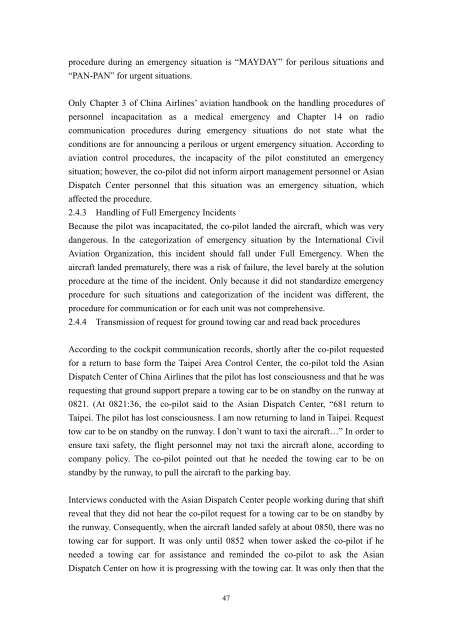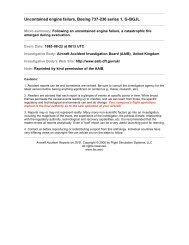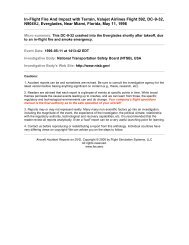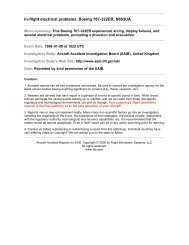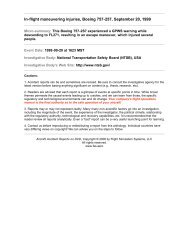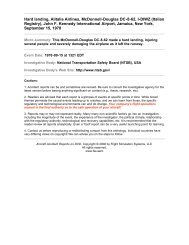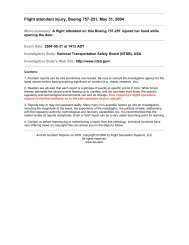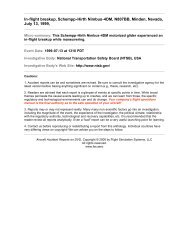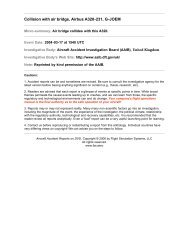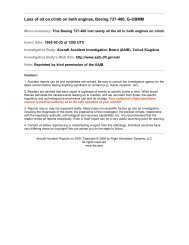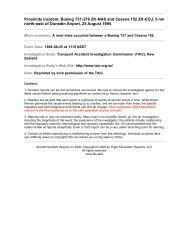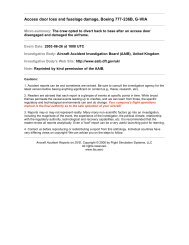Executive Summary - Fss.aero
Executive Summary - Fss.aero
Executive Summary - Fss.aero
You also want an ePaper? Increase the reach of your titles
YUMPU automatically turns print PDFs into web optimized ePapers that Google loves.
procedure during an emergency situation is “MAYDAY” for perilous situations and<br />
“PAN-PAN” for urgent situations.<br />
Only Chapter 3 of China Airlines’ aviation handbook on the handling procedures of<br />
personnel incapacitation as a medical emergency and Chapter 14 on radio<br />
communication procedures during emergency situations do not state what the<br />
conditions are for announcing a perilous or urgent emergency situation. According to<br />
aviation control procedures, the incapacity of the pilot constituted an emergency<br />
situation;<br />
however, the co-pilot did not inform airport management personnel or Asian<br />
Dispatch Center personnel that this situation was an emergency situation, which<br />
affected the procedure.<br />
2.4.3 Handling of Full Emergency Incidents<br />
Because the pilot was incapacitated, the co-pilot landed the aircraft, which was very<br />
dangerous. In the categorization of emergency situation by the International Civil<br />
Aviation Organization, this incident should fall under Full Emergency. When the<br />
aircraft landed prematurely, there was a risk of failure, the level barely at the solution<br />
procedure at the time of the incident. Only because it did not standardize emergency<br />
procedure for such situations and categorization of the incident was<br />
procedure<br />
for communication or for each unit was not comprehensive.<br />
standby by the runway, to pull the aircraft to the parking<br />
bay.<br />
different, the<br />
2.4.4 Transmission of request for ground towing car and read back procedures<br />
According to the cockpit communication records, shortly after the co-pilot requested<br />
for a return to base form the Taipei Area Control Center, the co-pilot told the Asian<br />
Dispatch Center of China Airlines that the pilot has lost consciousness and that he was<br />
requesting that ground support prepare a towing car to be on standby on the runway at<br />
0821. (At 0821:36, the co-pilot said to the Asian Dispatch Center, “681 return to<br />
Taipei. The pilot has lost consciousness. I am now returning to land in Taipei. Request<br />
tow car to be on standby on the runway. I don’t want to taxi the aircraft…” In order to<br />
ensure taxi safety, the flight personnel may not taxi the aircraft alone, according to<br />
company policy. The co-pilot pointed out that he needed the towing car to be on<br />
Interviews conducted with the Asian Dispatch Center people working during that shift<br />
reveal that they did not hear the co-pilot request for a towing car to be on standby by<br />
the runway. Consequently, when the aircraft landed safely at about 0850, there was no<br />
towing car for support. It was only until 0852 when tower asked the co-pilot if he<br />
needed a towing car for assistance and reminded the co-pilot to ask the Asian<br />
Dispatch Center on how it is progressing with the towing car. It was only then that the<br />
47


